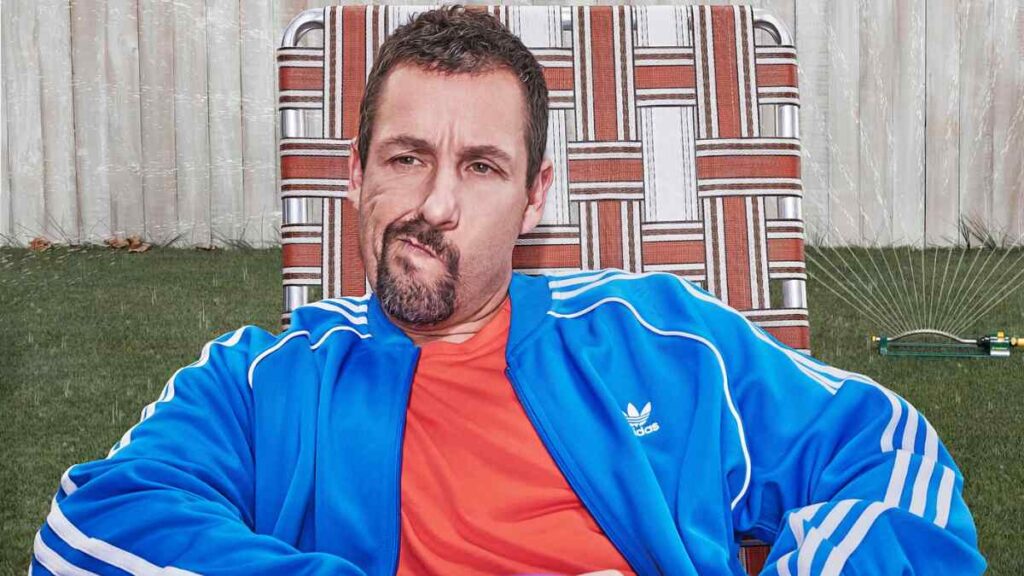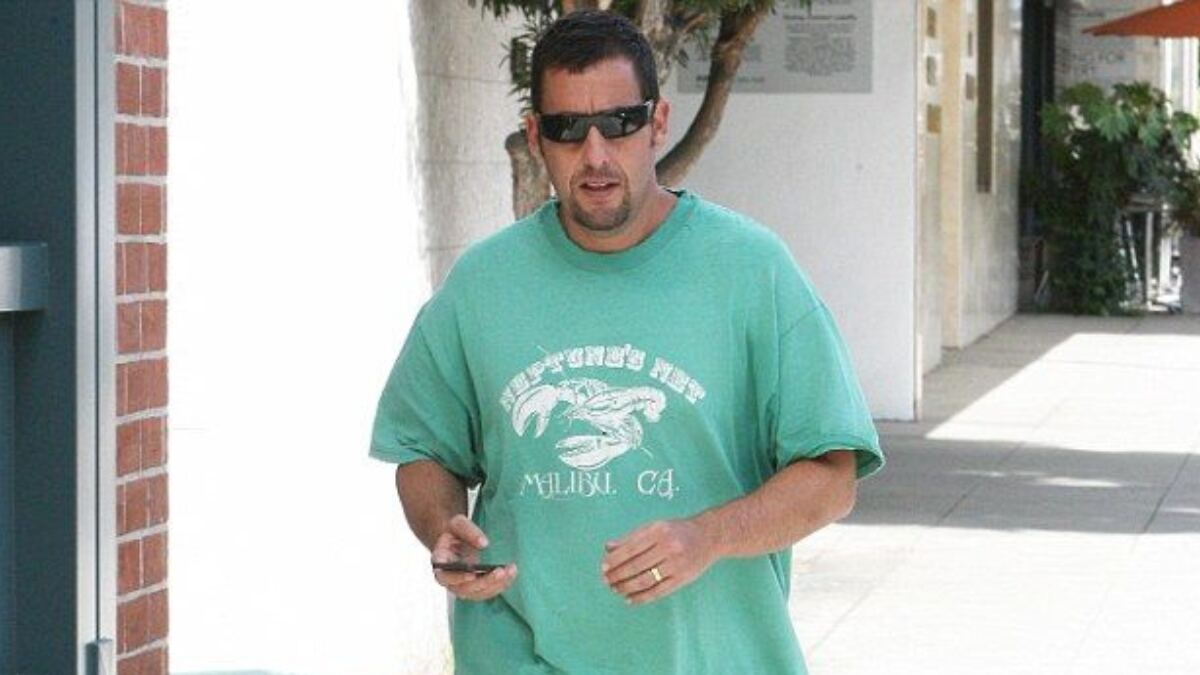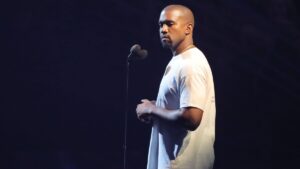There’s Adam Sandler again — cargo shorts hanging below the knee, a faded Knicks T-shirt clinging to his torso like it’s been through a hundred laundry cycles, and sneakers that look like they’ve logged more steps than a fitness influencer. He’s strolling past a velvet rope at a movie premiere, flanked by celebrities whose stylists charged four digits to make them look “effortless.” And yet, all eyes are on Sandler.
Why?
Because in a world obsessed with polish and perfection, Sandler stands out by doing the opposite — and he does it without apology. The images keep going viral: Sandler at Cannes looking like he’s on a CVS run, or photographed next to Jennifer Aniston in couture while he’s dressed like it’s Sunday morning and he’s forgotten to take the trash out.
It would be easy to call it laziness, but that would miss the point. Sandler’s fashion — if you can even call it that — feels like the ultimate shrug to Hollywood’s obsession with appearance. And that shrug, oddly enough, is what’s made him a low-key icon.
This isn’t just a man in oversized mesh shorts. It’s a man who built a career on comfort — in humor, in fame, and now, in clothes. Somehow, that aesthetic has become not just tolerated, but celebrated. In 2025, comfort might just be the new cool — and Sandler got there first.
Unbranded Swagger: A Deep Dive into Sandler’s Signature Look
Baggy Basketball Shorts and XXL Tees: The Uniform of Anti-Style
Imagine the scene: Adam Sandler shuffles out of a Manhattan hotel, iced coffee in hand, phone to his ear, and dressed like he’s en route to a middle school gym class. His basketball shorts — often reaching mid-shin — billow like sails, usually in some shade of navy or gray. His T-shirt, stretched two sizes too big, bears the name of a college he probably never attended. There might be a hoodie involved, depending on the breeze. And on his feet? Always the practical pick — Reebok Classics, chunky New Balances, or UGG slippers that have seen better days.
But this isn’t accidental chaos. There’s a pattern in the anti-pattern. The clothes are uniform in their refusal to conform. There’s no tailoring, no sleek silhouettes, no subtle flex of wealth. In a culture where male celebrities are expected to dress with curated effort — crisp lines, designer brands, Instagram-readiness — Sandler’s look doesn’t just buck the trend. It stomps on it with the orthotic insoles of a man who doesn’t care. And that, ironically, is what makes it magnetic.
The Style Is Not Lazy — It’s Intentional
To dismiss Adam Sandler’s look as careless is to miss the quiet genius behind it. He’s not showing up to press junkets in baggy Champion shorts because he forgot to pack his tux — he’s doing it because he can. In an industry built on image maintenance, Sandler’s anti-style reads less like laziness and more like rebellion.
In a 2023 interview with GQ, Sandler admitted, “I dress like this because it makes me happy… I’m not trying to be disrespectful. I just like feeling good.” That offhand explanation reveals something deeper: his wardrobe is a subtle act of resistance against the exhausting machinery of Hollywood grooming.
Where most actors are outfitted by stylists for public appearances, Sandler dresses himself — often in the same rotation of tees and gym shorts you’d find in a college dorm. And yet, he keeps getting cast, keeps making bank, and keeps showing up looking the same. That’s not fashion apathy. That’s a power move disguised as a punchline.
“He Looks Like All of Us”: Why Audiences Embrace the Everyman Uniform
There’s something oddly comforting about seeing Adam Sandler out in public looking like your uncle who wandered out of the house for milk and forgot he was famous. The oversized T-shirt. The wrinkled mesh shorts. The sneakers with no discernible brand cachet. It’s not glamorous — and that’s exactly the point.
In a culture oversaturated with curated perfection, Sandler offers a rare glimpse of relatable celebrity. His outfits don’t intimidate or inspire envy; they reassure. He looks like someone you’d see at a CVS in the middle of a heatwave, muttering about Gatorade flavors. And in a way, that kind of casual masculinity — free from designer logos and performance — feels revolutionary.
This affection only deepened during the pandemic, when the world collectively traded in its skinny jeans for sweatpants and learned to appreciate comfort as a form of self-preservation. Sandler wasn’t adjusting to the moment — he was the moment. While other celebrities posted stylized “at home” photos in $300 loungewear, he remained unchanged, walking around in dad-core gear like he had nothing to prove.
Psychologically, it’s a balm. We like our stars to be aspirational, but we love it when they’re approachable. Sandler’s aesthetic isn’t just anti-fashion — it’s anti-facade. It says, “You don’t have to pretend to be more than you are to be loved.” In a social media world full of filters and flexing, that message cuts through.
There’s also an authenticity at play that speaks to men in particular, especially those who have grown tired of the performative pressures of style. Sandler represents a kind of freedom: not just to dress how you want, but to be publicly indifferent about it. And that indifference? It’s weirdly aspirational.
Because deep down, most of us just want to be comfortable — and seen. Sandler does both.
Sandler vs. The Suits: What Sets Him Apart in Hollywood’s Style Ecosystem
Picture this: a red carpet group shot featuring Adam Sandler, Ryan Gosling, Jonah Hill, and Dwayne “The Rock” Johnson. It’s not just a study in celebrity — it’s a masterclass in aesthetic contrast.
Gosling, ever the smooth operator, would likely show up in a perfectly tailored suit with subtle retro flair — all charm and cinematic precision. He’s Hollywood’s golden boy, wrapped in linen and smirking knowingly, his look whispering, I woke up like this, but in a French hotel. Then there’s The Rock, who’s turned his body into a brand. You’ll catch him in tight-fitting designer polos or monochromatic power suits — calculated dominance in motion. Even his fashion says, I’m built different.
Jonah Hill, once a comedic wingman to Sandler himself, has evolved into a streetwear-savvy icon. With brands like Palace, Loewe, and Adidas on rotation, he’s proof that you can flip the script — from goofy sidekick to skate-park couture muse.
And then there’s Sandler.
Loose basketball shorts, neon trail runners, a T-shirt that may or may not have come from a college giveaway. He looks like he’s here to drop someone off, not pose for flashbulbs. But that’s the trick: while everyone else is styled for optics, Sandler is styled for himself.
What sets him apart isn’t just comfort — it’s refusal. In a celebrity culture obsessed with reinvention and branding, Sandler’s consistent anti-style becomes its brand. He’s immune to the cycle of trend-chasing, and that makes him… weirdly timeless.
In this imaginary lineup, Sandler wouldn’t just stand out visually — he’d mean something different. While the others perform aspiration, Sandler performs authenticity. And that’s why, even in his Costco-core, he somehow steals the frame.
Celebrity Style Comparison Table
| Celebrity | Style Archetype | Signature Look | Public Perception |
|---|---|---|---|
| Adam Sandler | Anti-fashion | Baggy shorts, oversized tee | Relatable, rebellious |
| Jonah Hill | Streetwear chic | Palace x Gucci | Cool, edgy |
| Ryan Gosling | Sleek modernist | Tailored suits | Effortlessly suave |
Beyond Clothes: The Philosophy of Comfort as Cultural Resistance
Adam Sandler may not see himself as a fashion philosopher, but his wardrobe choices tell a deeper story — one that challenges the performance of celebrity itself.
In an industry built on illusion and aspirational polish, Sandler’s aesthetic feels almost radical. He doesn’t reject fashion entirely — he just refuses to play by its rules. And in doing so, he exposes the machinery behind the red carpet: the stylists, the brand partnerships, the months of curated public appearances designed to sell an image. Sandler opts out, not loudly, but with every oversized tee and worn-down sneaker. That quiet refusal is its form of protest.

Cultural theorist Anne Hollander once argued that fashion is “a form of visual truth-telling.” If that’s the case, then Sandler’s truth is about comfort, not conformity — and that resonates. Especially now.
In an age of remote work, pandemic-era introspection, and growing awareness of mental health, the public is increasingly drawn to figures who don’t posture for approval. Sandler’s look, once mocked, now mirrors a broader cultural shift: we no longer equate effort with value. His aesthetic lines up with the growing appeal of “unbothered masculinity” — a soft rejection of status anxiety, gendered performance, and image obsession.
Of course, comfort is a kind of privilege. Only someone with Sandler’s wealth and legacy can dress like he rolled out of a college dorm and still command respect in Hollywood. But maybe that’s also the point: he uses his privilege not to gatekeep, but to opt out.
In that way, Sandler’s clothes don’t just hang off him — they speak for him. And what they’re saying is: you don’t need to look like a brand to have value.
My Encounter with Sandler Style: A Personal Reflection from the Hoodie Section
It started with a pair of mesh basketball shorts and a hoodie two sizes too big. Not because I was doing research — I had simply stopped caring that morning. The hoodie came from a clearance bin. The shorts were old enough to have an ex’s laundry tag still stitched inside. I slid into beat-up sneakers, grabbed an iced coffee, and headed to the grocery store.
That’s when it hit me: I looked exactly like Adam Sandler.
Not the actor version. The walking-down-the-street, possibly-going-to-pick-up-a-muffin Sandler. And for the first time in a while, I felt… unbothered. Not stylish. Not ironic. Just physically and mentally at ease.
People glanced at me, but I didn’t care. I was dressed for air flow, not approval. There was something strangely powerful in the indifference — like I’d opted out of a game I didn’t remember agreeing to play. My body could relax. My shoulders stopped trying to posture.
That’s the thing about the Sandler aesthetic: it’s not just clothes, it’s an attitude. A walking protest against the need to be seen as impressive. And it’s contagious.
I’ve worn that outfit again. Sometimes just around the house, other times out in public. And each time, I feel like I’m borrowing a little piece of his freedom — the kind that doesn’t need a stylist, or a brand deal, or even clean socks.
It turns out, dressing like you have nothing to prove might be one of the most quietly confident moves you can make.
How Sandler’s Anti-Fashion Is Quietly Influencing High Fashion
It’s one of fashion’s more delicious ironies: the very look Adam Sandler’s been mocked for — baggy shorts, shapeless hoodies, orthopedic sneakers — is now walking down the runways of Paris.
Designers like Demna (of Balenciaga fame) and Vetements have built entire collections on oversized silhouettes, exaggerated comfort, and a kind of nihilistic dressing that wouldn’t look out of place on Sandler’s morning coffee run. Think massive puffer jackets, intentionally ugly sneakers, and T-shirts that swallow the torso whole — all rebranded as cutting-edge “post-streetwear minimalism.”
Fashion writer Rachel Tashjian once quipped that “Sandler is normcore’s final boss.” She’s not wrong. What was once seen as slouchy and unserious has become aspirational — a kind of curated carelessness that luxury houses now sell for thousands.
Of course, Sandler himself isn’t strategizing this. He’s not sending mood boards to stylists or working with creative directors. That’s what makes the influence so potent: it’s completely unintentional. And in a space where every aesthetic move is calculated, his indifference becomes the ultimate form of disruption.
Even stylists admit it. In a 2022 GQ roundtable, one commented, “Sandler’s look is one of the few truly authentic styles in Hollywood. People respond to that — and designers pay attention.”
What once got him dubbed “worst dressed” is now fashion’s mood board fuel. It’s a cultural about-face that says more about us than him. Because as much as we mock comfort-core, we also crave it. Sandler just got there first — in tube socks.
The Legacy of Looking Comfortable: Will the Sandler Aesthetic Stick?
Is the Sandler aesthetic just a meme with great legs (and baggy shorts), or is it the beginning of something more enduring? Signs point to the latter.
Younger celebs like Pete Davidson and Seth Rogen have embraced the same fashion-agnostic vibe — loose fits, thrift-store energy, and a general “I just woke up, and it’s fine” attitude. It’s not about making a statement, but about refusing to. And that refusal? It’s catching on.
In a time when personal brands are sculpted to algorithmic perfection and every celebrity outfit looks like a sponsored ad, Sandler’s disinterest feels oddly… authentic. Not because it’s performatively humble, but because it doesn’t seem performative at all.
Fashion cycles always swing — but comfort, once a backstage indulgence, has moved to the main stage. And while trends may drift back to sharp tailoring and sleek silhouettes, Sandler’s legacy will likely linger. He showed us that you don’t need to be dressed up to show up.
Maybe that’s the real style evolution: trading aspiration for approachability. Because in an age of polished personas, comfort might just be the last honest choice we have.
Nishant Wagh is the founder of The Graval and a seasoned SEO and content strategist with over 15 years of experience. He writes with a focus on digital influence, authority, and long-term search visibility.





6 thoughts on “The Adam Sandler Aesthetic: How Comfort Became a Style Statement in Hollywood”